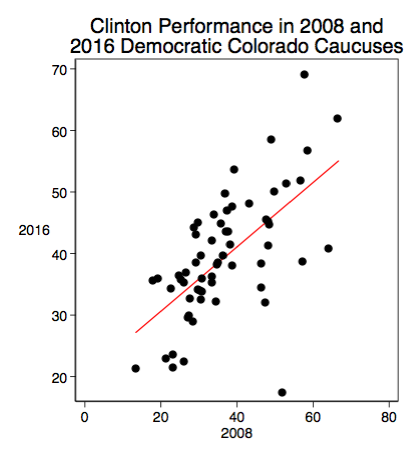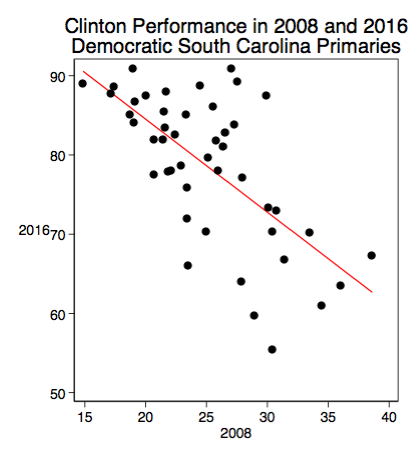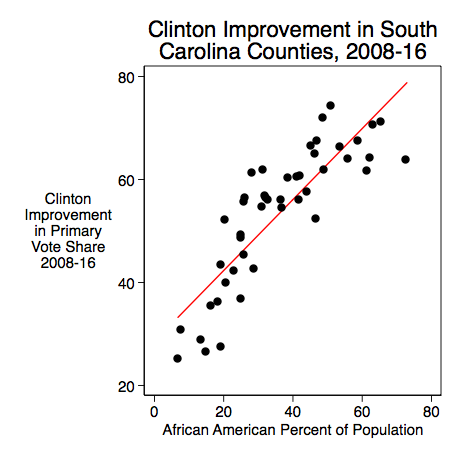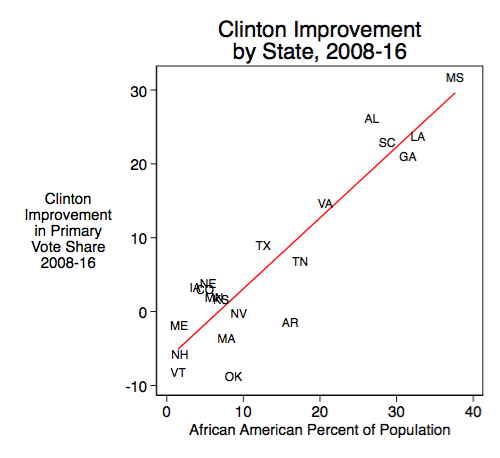Hillary Clinton has been in a strong position to win the Democratic presidential nomination this year for some time. Of course, she was also in a strong position in 2007 and it didn’t quite happen for her then. But one of the biggest differences in this cycle has been the allegiances of African-American voters in Democratic primaries and caucuses. While they were strongly in Barack Obama’s camp eight years ago, they’re strongly in Clinton’s this year.
I discussed this a few weeks ago, noting that the main difference between Obama’s coalition in 2008 and Bernie Sanders’ coalition this year is the latter’s lack of African Americans. But now we can see how this is playing out in some state contests.
Interestingly, Clinton has done about as well this year as she did in 2008 in states without large African-American populations. Take, for example, Colorado. Roughly five percent of the state’s population is African American, and that five percent is heavily concentrated in just a handful of counties. The scatterplot below shows how Clinton did in the Democratic caucuses there in 2008, broken down by county:

This is a very strong positive relationship, with one variable predicting the other very nicely. She got about 32 percent of the caucus vote there in 2008 and about 35 percent last month, and counties stuck pretty close in their allegiances between the two election cycles. A county that liked her a lot eight years ago still likes her a lot now.
OK, now let’s do the same analysis for the Democratic primary in South Carolina, where 29 percent of the state’s population is African American:

This is a very strong negative correlation. The counties where Clinton ran the weakest in 2008 are those where she ran the strongest in 2016. And as the plot below shows, the counties where she made the sharpest improvements between 2008 and 2016 are those with the highest percentages of African Americans:

We can see this same pattern emerging across all the states that have had contests so far:

All of this just underscores the fact that African Americans are making the real difference for Clinton. When Obama ran in 2008, claiming large majorities of African-American primary voters and caucusgoers, that meant that a large (over 20 percent of Democrats) and enthusiastic portion of the Democratic electorate was simply unavailable to Clinton. Her years of seeking to appeal to African-American leaders and voters are clearly paying off for her this year.
For what it’s worth, the African-American percentage of the vote in the states that have not yet held Democratic contests this year is around 10 percent, which would translate to Clinton improving her 2008 vote share by around three points. Also, this very simple model suggests that Clinton will only win four states that haven’t voted yet that she failed to win in 2008—Connecticut, Delaware, Maryland, and Missouri. Now, that analysis is only based on two variables and doesn’t take into account the translation of those vote shares into delegates, among other factors, so I wouldn’t read too much into it. But judging by the results so far, Clinton is on a steady path to clinch the nomination, and African Americans are a large part of the reason why.





